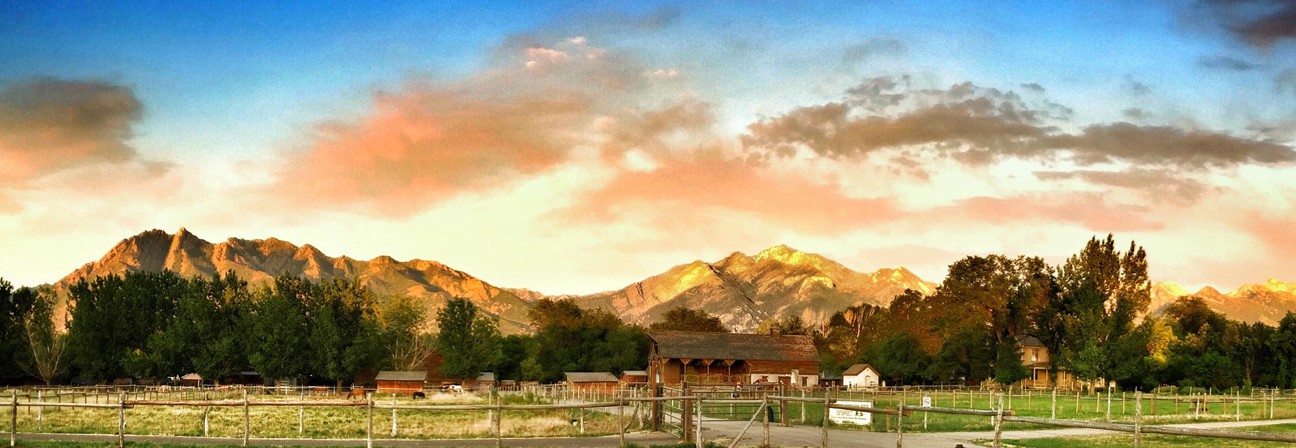History
Wheeler Historic Farm has a rich history in Salt Lake County, with many individuals living and/or harvesting on the farm since the mid-1800s.
Wheeler Historic Farm has a rich history in Salt Lake County, with many individuals living and/or harvesting on the farm since the mid-1800s.

The Wheelers owned and occupied the 75-acre farm for 56 years. During the Wheeler’s tenure on the farm, they had seven children and, in later years, two grandchildren.
When first moving to the farm, the Wheelers lived in the adobe home built by Ole Hanson. Sariah, a genteel country lady, preferred a spacious, nicely appointed Victorian farmhouse, which inspired the construction of the home currently on the property. The interior walls were constructed with adobe bricks from the old house, which added great insulation to the home. Several out-buildings surrounded the home, and many remain today. One such building is the family garage, which is believed to be where Henry kept his great car: the Pierce-Arrow.
The Wheelers, much like their neighbors, survived hard times by growing their own food, owning their own milk cows, and raising their own cattle for beef on their flourishing farm. The Rosebud Dairy, circa 1912-1933, was a commercial business established by Henry that produced enough milk to supply neighbors and others. This business was supplemented by selling ice blocks harvested during the winter and sold through the spring and early summer to provide refrigeration for many residents. The Rosebud Country Store, an active onsite retail store selling local wares, exists in tribute to Rosebud Dairy and Henry’s commitment to local farmers and artisans.
When Sariah died in 1928, Henry Jr. and his family moved back to the farm and took care of Henry Sr. for 15 years, until he passed away in 1943.
Following the death of Henry Sr., the farm was sold to Sterling Furniture Company and its president Richard Madsen. The Madsens operated the Golden Guernsey Cattle Ranch on the farm, breeding fine dairy cows and making many improvements to the farm.
Salt Lake County acquired the farm in 1969. At the time, the buildings were boarded up and in need of extensive care. Additionally, the farmyard was filled with debris from years of neglect. Salt Lake County originally intended to remove the historic structures and develop the land as a regional park with ball fields, tennis courts, and other recreational facilities.
In 1974, Junior League of Salt Lake conducted extensive research and proposed a concept plan to Salt Lake County to preserve the farm structures and create a living, working historic farm. The County endorsed the plan and, with much enthusiasm and significant seed money, adopted this as their Bicentennial project for the community; doing so was no small undertaking. The Junior League developed a plan and raised funds from other entities such as the Bicentennial Commission, Community Development Funds, and the National Historic Preservation Foundation. A curator was hired, and the volunteers began the massive yard clean up and long process of restoring the farmhouse and acquiring artifacts for its decor.
Beverly Wheeler Mastrim assisted with research and preparation of the National Register nominations from 1974–1976. In May of 1976, Wheeler Historic Farm formally opened to the public. Dr. A. Glen Humphreys—curator, farmer, and director—and his family moved into a trailer located on the Wheeler Farm property. Dr. Humphrey’s contributions, as director and curator for more than 25 years, are still a part of what you find at the farm today.
Wheeler Farm Friends, a 501(c)3 nonprofit, was created to assist Wheeler Historic Farm with fundraising and other auxiliary services. Henry Jr’s daughters, Beverly Wheeler Mastrim and Jean Wheeler Allen, were actively involved in these efforts and the continued preservation of the farm.
Today, Wheeler Historic Farm is operated by Salt Lake County Parks and Recreation as an agricultural museum and outdoor recreation site. Throughout the 75-acre site, additional buildings can be viewed including a milking parlor, historic garage with displays, and a turn-of-the-century root cellar. Nine of the structures original to the farm are listed on the state and local register of historic places. Farm house tours are available for a small fee.
Wheeler Farm is the home to nearly 6,000 artifacts and educational pieces associated with Utah’s agricultural history and early farm life (1887-1940). The majority of these artifacts are on display on the grounds or in one of the many buildings found at the farm.
If you would like Wheeler Historic Farm to consider a historic artifact donation, please contact Sara Roach, Heritage Preservation Manager. We specifically look for items related to Victorian Farming from the late 1800 to early 1900s.
The original Victorian style Wheeler farmhouse and its many items showcase the domestic side of farm life 1890-1940. The Machinery Barn displays highlights equipment supporting the operation of a turn of the century working farm.
The Activity Barn’s second floor provides changing exhibits related to early farming. Original research information about the Wheelers, the surrounding area and the progressive farm period are also available among the library resources found in the Activity Barn.
Please visit our photo exhibit. Photos have been provided in cooperation with the Utah State History Advisory Board.